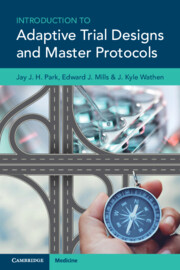Book contents
- Introduction to Adaptive Trial Designs and Master Protocols
- Introduction to Adaptive Trial Designs and Master Protocols
- Copyright page
- Content
- Preface
- About the Authors
- Part I Introduction and History of Clinical Trial Research
- Part II Basic Ingredients for Adaptive Trial Designs and Common Types
- Part III Basic Ingredients for Master Protocols
- Part IV Case Studies of Adaptive Trial Designs and Master Protocols
- Chapter 9 Case Studies of Adaptive Trial Designs
- Chapter 10 Case Studies of Platform Trials
- Chapter 11 Case Studies of Basket Trials and Umbrella Trials
- Chapter 12 Standards and Guidelines for Adaptive Trial Designs and Master Protocols
- Part V A Practical Guide to Adaptive Trial Designs and Master Protocols
- Index
- References
Chapter 9 - Case Studies of Adaptive Trial Designs
from Part IV - Case Studies of Adaptive Trial Designs and Master Protocols
Published online by Cambridge University Press: 20 March 2023
- Introduction to Adaptive Trial Designs and Master Protocols
- Introduction to Adaptive Trial Designs and Master Protocols
- Copyright page
- Content
- Preface
- About the Authors
- Part I Introduction and History of Clinical Trial Research
- Part II Basic Ingredients for Adaptive Trial Designs and Common Types
- Part III Basic Ingredients for Master Protocols
- Part IV Case Studies of Adaptive Trial Designs and Master Protocols
- Chapter 9 Case Studies of Adaptive Trial Designs
- Chapter 10 Case Studies of Platform Trials
- Chapter 11 Case Studies of Basket Trials and Umbrella Trials
- Chapter 12 Standards and Guidelines for Adaptive Trial Designs and Master Protocols
- Part V A Practical Guide to Adaptive Trial Designs and Master Protocols
- Index
- References
Summary
In this chapter, we review six case studies of adaptive clinical trials. This chapter is intended to complement the previous chapters. We have organised the case studies by their main adaptive design feature. Each case study describes the background of individual trial and summarises key design details and overall results. Our presentation and discussion do not necessarily represent the official view of the trial investigators. Our discussion is intended to improve the reader’s general literacy and comprehension of published results of adaptive clinical trials.
Keywords
- Type
- Chapter
- Information
- Introduction to Adaptive Trial Designs and Master Protocols , pp. 101 - 114Publisher: Cambridge University PressPrint publication year: 2023



